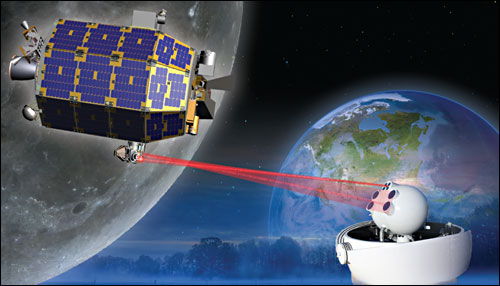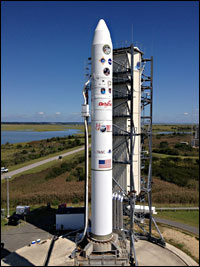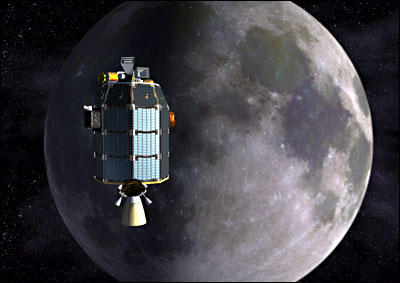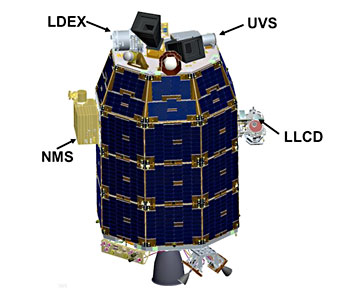
Lunar Mission to Test Space Laser
WALLOPS ISLAND, Va., Sept. 6, 2013 — With the upcoming launch of NASA's moon-orbiting Lunar Atmosphere and Dust Environment Explorer (LADEE), the space agency is also venturing into what it hopes will be a new era of broadband space communications using lasers.
 LADEE, a robotic mission that will orbit the moon to gather detailed information about its atmosphere, conditions near the surface, and environmental influences on lunar dust, will be launched on a Minotaur V vehicle sometime during a five-day launch period that opens at 11:27 p.m. EDT Sept. 6. It will be the first planetary mission to launch from the Wallops Flight Facility.
LADEE, a robotic mission that will orbit the moon to gather detailed information about its atmosphere, conditions near the surface, and environmental influences on lunar dust, will be launched on a Minotaur V vehicle sometime during a five-day launch period that opens at 11:27 p.m. EDT Sept. 6. It will be the first planetary mission to launch from the Wallops Flight Facility.
Aboard LADEE is technology associated with NASA's Lunar Laser
Communication Demonstration (LLCD), the space agency's first attempt to
show that two-way laser communication beyond Earth is possible. NASA is
looking to laser communication as the next paradigm shift in future
space communication, especially deep space.

Artist’s rendering of the LADEE Spacecraft with LLCD. Courtesy of NASA.
LLCD's main mission objective is to transmit hundreds of millions of bits of data per second from the moon to Earth, the equivalent of transmitting more than 100 high-definition television channels simultaneously, NASA said. LLCD's receiving capability will also be tested as tens of millions of bits per second are sent from ground stations on Earth to the spacecraft. The demonstrations will prove that the technology for increased bandwidth is possible for future missions, something that could one day allow for 3-D HD video transmissions in deep space to become routine.
"LLCD is designed to send six times more data from the moon using a smaller transmitter with 25 percent less power as compared to the equivalent state-of-the-art radio (RF) system," said Don Cornwell, LLCD manager. "Lasers are also more secure and less susceptible to interference and jamming."

LADEE is scheduled for launch at 11:27 p.m. EDT on Sept. 6 from Pad 0B at the Mid-Atlantic Regional Spaceport at NASA's Wallops Flight Facility in Wallops Island, Va. Courtesy of NASA EDGE/Franklin Fitzgerald.
In the past, NASA has experimented with sending low amounts of individual pulses to cameras on far-away space probes near Jupiter, Mars and Mercury.
Recently, an image of “Mona Lisa,” the painting by Leonardo da Vinci, was transmitted to NASA's Lunar Reconnaissance Orbiter (LRO) spacecraft orbiting the moon (See: Lunar Orbiter Lasers Mona Lisa to Moon). "But this was done at only hundreds of data bits per second," Cornwell said. "LLCD will be the first dedicated optical communication system and will send data millions of times faster."
The European Space Agency has successfully demonstrated laser communication between satellites in Earth orbit. Recently they launched Alphasat to demonstrate laser transmission between a low-Earth orbit satellite and a satellite in geostationary Earth orbit, but LLCD's laser link from the moon will be 10 times farther away.
The short LLCD mission is a precursor to NASA's long-duration demonstration, the Laser Communications Relay Demonstration (LCRD), which is scheduled to launch in 2017.
The primary ground terminal to receive and transmit LLCD signals is at NASA's White Sands Complex in New Mexico. There are two alternate sites, one at NASA's Jet Propulsion Laboratory in California, which is for receiving only. The other is being provided by the European Space Agency on the Spanish island of Tenerife, off the coast of Africa. It will have two-way communication capability with LLCD.
"Having several sites gives us alternatives, which greatly reduces the possibility of interference from clouds," Cornwell said.
The goal of the LLCD experiment, he said, "is to validate and build confidence in this technology so that future missions will consider using it. We can even envision such a laser-based system enabling a robotic mission to an asteroid. It could have 3-D, high-definition video signals transmitted to Earth, providing essentially ‘telepresence’ to a human controller on the ground."

Artist's depiction of NASA's Lunar Atmosphere and Dust Environment Explorer (LADEE) observatory as it approaches lunar orbit. Courtesy of NASA Ames/Dana Berry.
The LADEE mission is scheduled to last approximately 160 days: 30 days to travel to the moon, 30 days for checkout and 100 days for science operations. The mission will attempt to confirm whether dust caused a mysterious glow on the lunar horizon that astronauts observed during several Apollo missions, and to explore the moon's tenuous, exotic atmosphere.
The 100-day science phase is performed at an orbit that will vary between 20 and 60 km due to the moon’s “lumpy” gravity field. During this phase, the moon will rotate more than three times underneath the LADEE orbit. The science phase will be followed by a "decommissioning" period, NASA said, during which the spacecraft's altitude will be made lower and lower until it hits the moon's surface.
Among the instruments aboard the spacecraft is the Lunar Laser Communications Demonstration (LLCD), NASA's first step in creating a high-performance space-based laser communications system. Currently, communications with spacecraft beyond close-Earth orbits require small, low-mass, low-power radio transmitters and giant satellite dishes on Earth to receive their messages. However, the goal of the LADEE spacecraft is to use lasers instead of radio waves to achieve broadband speeds to communicate with Earth.

Locations of LADEE's instruments. NASA's Lunar Atmosphere and Dust Environment Explorer (LADEE) is a robotic mission that will orbit the moon to gather detailed information about the lunar atmosphere, conditions near the surface, and environmental influences on lunar dust. A thorough understanding of these characteristics will address long-standing unknowns and help scientists understand other planetary bodies as well. Courtesy of NASA.
Other instruments aboard the 844-lb craft include the Ultraviolet and Visible Light Spectrometer, the Neutral Mass Spectrometer, and the Lunar Dust Experiment. The Ultraviolet and Visible Light Spectrometer (UVS) will determine the composition of the lunar atmosphere by analyzing light signatures of materials it finds. The Neutral Mass Spectrometer (NMS) will measure variations in the lunar atmosphere over multiple lunar orbits with the moon in different space environments, and the Lunar Dust Experiment (LDEX) will collect and analyze samples of any lunar dust particles in the tenuous atmosphere. These measurements will help scientists address a long-standing mystery: Was lunar dust, electrically charged by solar ultraviolet light, responsible for the presunrise horizon glow that the Apollo astronauts saw?
NASA's Ames Research Center in Silicon Valley designed, developed, built and tested the spacecraft and will manage the 100-day science mission. After launch, Ames will control the spacecraft and execute mission operations.
For more information on LLCD, visit: http://llcd.gsfc.nasa.gov
For more about the LADEE mission, visit: www.nasa.gov/ladee
Published: September 2013